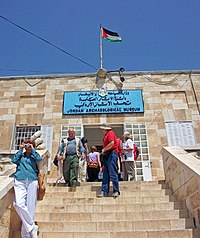Jordan Archaeological Museum
| متحف الآثار الأردني | |

Museum entrance, 2009
|
|
| Established | 1951 |
|---|---|
| Location |
Citadel Hill, Amman Jordan |
| Coordinates | 31°57′14″N 35°56′03″E / 31.9540°N 35.9343°E |
| Type | Art museum, Design/Textile Museum, Historic site |
| Director | Abdul Rahim Al Dwaikat |
The Jordan Archaeological Museum is located in the Amman Citadel of Amman, Jordan. Built in 1951, it presents artifacts from archaeological sites in Jordan, dating from prehistoric times to the 15th century. The collections are arranged in chronological order and include items of everyday life such as flint, glass, metal and pottery objects, as well as more artistic items such as jewelry and statues. The museum also includes a coin collection.
The museum formerly housed some of the Dead Sea Scrolls, including the only copper scroll, which are now on display in the newly established Jordan Museum, along with the Ain Ghazal statues, which are among the oldest statues ever made by human civilization..
The museum was established in 1951 on top of the Amman Citadel in the heart of Amman. Another branch of the museum was established in East Jerusalem which was under Jordanian rule prior to the 1967 war. Once East Jerusalem fell to Israel in 1967, the museum lost all of its collection in the Jerusalem branch including most of the Dead Sea Scrolls.
The museum is located in the Amman Citadel in Amman, one of the oldest continuously inhabited places in the world. Two historic sites are nearby on top of the hill, the Roman Temple of Hercules that dates back to the 2nd century, and an Umayyad palace that dates back to the 8th century. Prior to 1967, the museum had a branch in East Jerusalem.
The collections of the museum belong to the following periods:
...
Wikipedia

